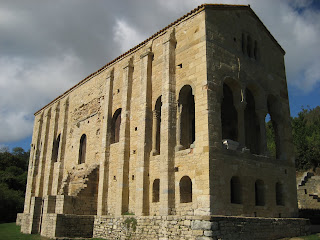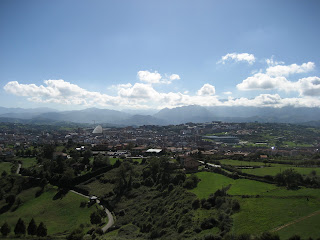I think I have already mentioned this, but Oviedo is surrounded by mountains. Monte Naranco is in the north-west and is of medium height (I was told 600 meters, however many feet that is), I believe one of the lower hills to the north-east is called the Monte Sagrado, and in the south are the really tall mountains of the Sierra del Aramo (1500 meters, I think that's almost 5000 feet). The Sierra del Aramo includes the peak of El Angliru (L'Angliru in Asturian), which is kind of famous for being one of the steepest mountains ever to be part of a professional bicycling race, and has provoked the utter hatred of some past Vuelta a España riders. Monte Naranco is also the mountain that you may have seen in the background of some pictures of my campus, with a giant statue of Jesus at the summit.
But to get back on track, I caught the L10 bus near the train station and intended to ride it to the end of the line, to a place called the Centro Asturiano, which I assumed was some kind of museum or public information center about Asturias. The climb was pretty curvy and we went through a residential area with a lot of detached houses that have an excellent view out over the city. I was surprised when we got to the Centro Asturiano, though, because it was surrounded by a barbed wire fence (facing the wrong way, like the one at Westminster Canterbury that we joke is to keep the old people inside) and had a guard at the gate. The bus stopped and the guard got on and started checking to make sure everyone had some sort of card that they were showing her. Since I was at the back of the bus I had plenty of time to wonder what the hell was going on and what the implications of me not having that card were, and when she came to me I just explained that I didn't know what this place was but I was just trying to go to the monuments. She told me it's a private sports club/spa, and then yelled up to the driver to open the back door so I could get off and said to follow the road and I would get to the monuments. OK, I kind of wish there was some sort of notification that this particular public bus route ended at a private country club, but whatever, I'll walk down the road, I don't think the monuments are too far from here.
 The Centro Asturiano, I'm not sure why you guys can't play tennis at the bottom of the mountain, it's much flatter there . . .
The Centro Asturiano, I'm not sure why you guys can't play tennis at the bottom of the mountain, it's much flatter there . . . Hmm, I hope there are some monuments down here
Hmm, I hope there are some monuments down hereThe first monument that I came across was San Miguel de Lillo, which is situated very near another road that the bus didn't come up, where tourists can pull over their cars. I walked around for a few minutes, taking photos selectively so it looked like I was there alone, then got my picture taken in front for my mother and headed off to look for Santa María del Naranco.
 Santa María del Naranco, up the hill
Santa María del Naranco, up the hill Side view
Side view That little white box on the porch was engraved with some really old looking Latin writing, but I couldn't look at it up close because the church was closed. Also, I can't read Latin anyway.
That little white box on the porch was engraved with some really old looking Latin writing, but I couldn't look at it up close because the church was closed. Also, I can't read Latin anyway. Picture to show where the church is located, and also that lady's awkward picture-taking pose
Picture to show where the church is located, and also that lady's awkward picture-taking pose Different monument, same pose
Different monument, same poseOK, time to get off this mountain and go eat lunch. At this point I had decided that I wasn't going to climb back up to the Centro Asturiano, but would be better off trying to intersect the road the bus came up and then follow that down until I found another bus stop. This wasn't a bad plan, and it would have worked, but along the way I met a lady (whose name I never asked) out for a stroll. I asked her where the closest bus stop was and she told me she didn't know, but after I told her where I was going she told me it wasn't that far to walk, and if I wanted she could show me where to catch a path that leads to that part of town. Keep in mind that I was on top of a mountain and could actually see where I was trying to get to, and it looked pretty far to me, but I said why not. We walked down the highway and chatted for about 20 minutes and then we got to the start of a pedestrian path that was pretty much horizontal. She told me to follow that for about 2 kilometers and the next road it intersected, to take that road down the mountain and I should be home in half an hour.
Well I already knew from Amparo telling me how long it would take to walk places that Spanish people and I have very different concepts of time and distance, but I thought I would never get off this mountain. I think I missed the turn onto the road she had mentioned, because I never saw the landmark flower store she had described, and I got back to the vivienda about an hour and 15 minutes later. Nevertheless, it wasn't a difficult walk and there were good views of the city, which I have included below. I also ran into a French kid I had met on the trip to Covadonga; he was going to ride his bicycle all the way to the Jesus statue at the top. I'd like to make it up there some day, because the lady who showed me the path told me you can see the sea from up there, but it's going to take the better part of a morning, if not a day. OK no more rambling, here's the view from the path.
 Right half: Notice the Sierra del Aramo taller than the clouds at the far right, and the Palacio de Congresos slightly to the left of the center of the photo
Right half: Notice the Sierra del Aramo taller than the clouds at the far right, and the Palacio de Congresos slightly to the left of the center of the photo
 Left half: If you look right above that little house/shed on the hillside, that's about where I live
Left half: If you look right above that little house/shed on the hillside, that's about where I live
 The Jesus statue at the top, still pretty far away
The Jesus statue at the top, still pretty far away
Well I already knew from Amparo telling me how long it would take to walk places that Spanish people and I have very different concepts of time and distance, but I thought I would never get off this mountain. I think I missed the turn onto the road she had mentioned, because I never saw the landmark flower store she had described, and I got back to the vivienda about an hour and 15 minutes later. Nevertheless, it wasn't a difficult walk and there were good views of the city, which I have included below. I also ran into a French kid I had met on the trip to Covadonga; he was going to ride his bicycle all the way to the Jesus statue at the top. I'd like to make it up there some day, because the lady who showed me the path told me you can see the sea from up there, but it's going to take the better part of a morning, if not a day. OK no more rambling, here's the view from the path.
 Right half: Notice the Sierra del Aramo taller than the clouds at the far right, and the Palacio de Congresos slightly to the left of the center of the photo
Right half: Notice the Sierra del Aramo taller than the clouds at the far right, and the Palacio de Congresos slightly to the left of the center of the photo Left half: If you look right above that little house/shed on the hillside, that's about where I live
Left half: If you look right above that little house/shed on the hillside, that's about where I live The Jesus statue at the top, still pretty far away
The Jesus statue at the top, still pretty far away




Beautiful pictures, Patrick. Sounds like you are taking advantage of time to see all the cool sites.
ReplyDeleteNow that's what a foreign student should be doing with his spare time - wandering around and discovering things that a "tourist" wouldn't, and chatting it up with the locals. Nice work! -- Dad
ReplyDeleteWhat a beautiful place. I am so enjoying your pictures and narrative of your journeys. Aunt Connie
ReplyDeleteI stumbled across your post and it brought back many memories...I have family in Oviedo and used to visit them every summer, and we used to go up to "Naranco" every now and then just to get out of the city, it seemed. I knew the site had some significance to them, but I never really "got it." There were a lot of such old buildings to the eye of a child! My grandparents were married at Covadonga before they came to NYC before the Spanish Civil War. Thanks for sharing -- even if it was 2 years ago! - Rosemary (of the Botas family of Oviedo and the Montes family of Gijon and Sama de Langreao).
ReplyDelete